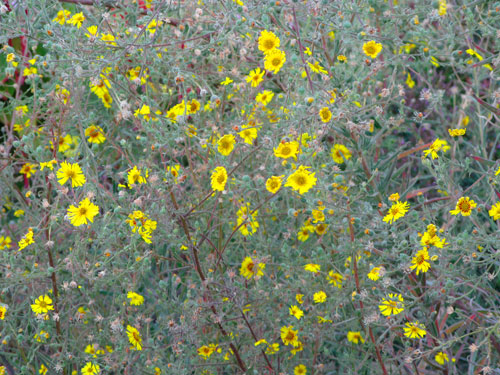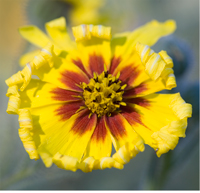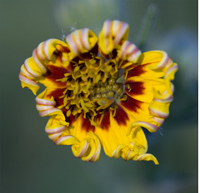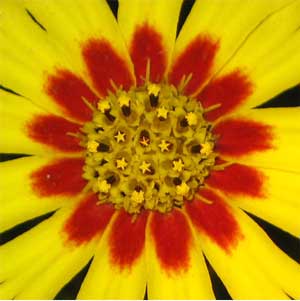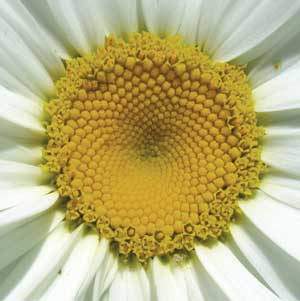|
This article first appeared in the April 2010 issue of
Lilipoh
magazine
The Healing Language of Plants: A Modern Alchemical Path
The Healing Language of Plants: A Modern Alchemical Path
When I first encountered the flower essences of Dr. Edward Bach in the mid 1970s, I was amazed at his remarkable powers of perception and intuition, and his ability to identify the subtle healing forces of flowering plants that could bring healing and balance to the human psyche. I wondered, “How was he able to do that?” Aside from quest to understand flower essences, I believed that such a profound soul-spiritual relationship with nature would be vital to healing the destructive alienation of modern civilization from the matrix of its natural environment.
Encountering the Madia Plant
The first step to understanding the language of plants is pure observation, direct sense experience of Nature. In this virtual-reality age of instant Google searches, this point cannot be overemphasized. We must follow Paracelsus’ admonition that to study the book of Nature, we must walk her pages with our feet.
Observing Madia’s Distinctive Flowering Rhythms
Returning in the early morning, in the cool light of the dawning day, we find the Madia flowers still fully open. Then, as the morning sun brightens and rises higher in the sky, we notice the ends of the ray florets curling inward to the center of the flower, as it returns to the compact bud-like state in which we found it the previous afternoon. We are reminded that plants are time organisms. Thus, it is impossible to fully know a plant with a single “snapshot” observation at a particular moment in time. Madia reveals itself both in the seasonal rhythms of its growth cycle — winter tap root to spring leaf rosette to summer blossoming and autumn death — and its diurnal rhythm of opening and closing in response to the light. (California Poppy — “the cup of gold” — for example, has the exact opposite light response, opening in the fullness of daylight, and closing not only at dusk, but when the sun is obscured by clouds.)
After observation, we can create an interior
image
of what we perceive with our senses, and then let the image live and grow as an inner experience of that we have perceived. If our inner picture is true to the phenomena itself — which takes considerable practice and skill — then this is what Goethe called “exact imagination,” giving us further insight into the formative forces working through the plant. This is a path of modern alchemical meditation and study, a re-creation in the microcosm of our own consciousness of the archetypal forces working through the plant, so that we can understand the healing forces at work in the plant remedy.
Madia’s Botanical Family
Having commenced a living connection with the plant, we now have a context in which for further observation, research and consideration of cultural, botanical, medicinal/nutritional, environmental and other properties of the plant.
6
Thus, it is apparent that Madia belongs to the Sunflower or Daisy plant family. (The name Daisy is derived from “Day’s Eye”) Its modern official name is Asteraceae , after the genus Aster, meaning “star.” These solar and stellar names for the family recognize the flower’s radial structure, but it is the composite quality that is its most characteristic signature, and thus the traditional family name Compositae . The structured orderliness of the composite flower head is both efficient and aesthetic, revealed especially in the intersecting spiral formed by the central disc florets, exhibiting the growth ratios of the Fibonacci series (seen in the Shasta Daisy image on the right). Thus the many parts of the composite flower, its central disk or tubular florets, and its outer ray or linguate (tongue-like) florets are organized into one coherent whole.
Habitat and History of Madia
Madia Concentrates Solar Warmth
Two other Compositae plants are well known for their nutritious seed oil, the Sunflower and Safflower. What does the oil signify? Wilhelm Pelikan, in his visionary book
Healing Plants (Heilphlanzenkunde),
provides the following insights about oil-bearing plants: “Volatile and fatty oils both relate to warmth, but otherwise they are polar opposites. In volatile oils, substance separates out into the warm element in a centrifugal process; in fatty oils, warmth turns into substance. Volatility is the essence of the former, concentration of the latter.”
9
The Inner Experience of Madia
Let us now return to an inner experience of the Madia. (In our plant studies we may spend many years of observation, study and contemplation.)
The Healing Message of Madia Flower Essence
Based on our living picture of the Madia, and as confirmed by three decades of practitioner reports through the
Flower Essence Society
, we can say confidently that the keywords for the Madia flower essence are
focus
and
concentration.
It is truly a remedy for our times, for our attention is pulled in so many directions, splintered into so many bits. Many of us live with a constant barrage of emails, phone calls, “tweets” and texts. Our mass media entertainment and video games are predicated on the viewer’s short attention span. Most people cannot hold a thought for more than an instant before the “monkey mind” runs off in another direction. Madia helps to calm and center both body and mind so that greater forces of concentration can be naturally developed by the soul itself in meditation, study and daily responsibilities requiring mindful focus. It has been helpful for those who are easily distracted, especially during the afternoon, or when exposed to heat, and for those with chronic problems of scattered attention, including Attention Deficit Disorder, a syndrome that could be a diagnosis for our contemporary society as a whole.
1 Originally published in 1931, see Barnard, Julian, ed. Collected Works of Edward Bach, Ashgrove Press, Bath, UK, 1988 2 Flower Essence Society, PO Box 459, Nevada City, CA 95959 www.flowersociety.org 3 See Bortoft, Henri, The Wholeness of Nature: Goethe’s way towards a science of conscious participation in nature . New York: Lindisfarne Press, 1966 and Seamon, David and Zajonc, Arthur, editors (1998). Goethe’s way of science: A phenomenology of nature. Albany, NY: State University of New York Press, 1998
4 Barnard, Julian,
The Healing Herbs of Edward Bach,
Ashgrove Press, Bath, UK, 1988 (currently out of print)
5 Zajonc, Arthur, Meditation as Contemplative Journey, Lindisfarne Books, Great Barrington, MA, 2009, pp 93-120. 6 For a fuller discussion see Kaminski and Katz, “The Twelve Windows of Plant Perception” at www.flowersociety.org/twelve.htm, and Katz, Richard, “The Living Science of Nature,” in Calix: International Journal of Flower Essence Therapy, Flower Essence Society, Nevada City, CA, 2004 7 For a discussion of Asteraceae flower essences see Kaminski, Patricia, “Extending the Legacy of Dr. Edward Bach,” in Calix: International Journal of Flower Essence Therapy, Flower Essence Society, Nevada City, CA, 2004
8 The Tarweed Gatherer
by Grace Carpenter Hudson (1865–1937), used with permission of the Grace Hudson Museum, Ukiah, California (www.gracehudsonmuseum.org). The woman pictured is well-known basketmaker Joseppa Pinto Dick (circa 1860-1905), who was Yokayo Pomo, a Native community southeast of Ukiah.
9 Pelikan, Wilhelm, Healing Plants, Mercury Press, Spring Valley, NY, 1988, pp 37-38 10 Part of the set of Affirm a Flower ™ affirmations and photos available published by the Flower Essence Society.
|

To install this Web App in your iPhone/iPad press ![]() and then Add to Home Screen.
and then Add to Home Screen.

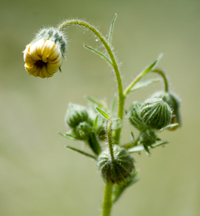 Yet, a mystery remains. Where are the flowers? A closer inspection finds many tightly closed buds, but no flowers. To see the flowers we must wait some hours for the cooling of eventide. Then the flowers unfold into radial star-forms, now fully open to the air and attenuated light. The multitude of brilliant and well-ordered flower forms stand out against the background of the rather drab and sometimes chaotic vegetative structures, and the dried out grasses and meadow plants that characterize the summer landscape of California’s Mediterranean climate.
Yet, a mystery remains. Where are the flowers? A closer inspection finds many tightly closed buds, but no flowers. To see the flowers we must wait some hours for the cooling of eventide. Then the flowers unfold into radial star-forms, now fully open to the air and attenuated light. The multitude of brilliant and well-ordered flower forms stand out against the background of the rather drab and sometimes chaotic vegetative structures, and the dried out grasses and meadow plants that characterize the summer landscape of California’s Mediterranean climate.